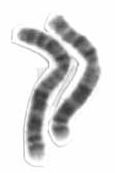
Photo from wikipedia
Collagen family members, the most abundant proteins in the human body, are widely used in biomedical fields and tissue engineering industries. However, the applications of collagen remain mostly relying on… Click to show full abstract
Collagen family members, the most abundant proteins in the human body, are widely used in biomedical fields and tissue engineering industries. However, the applications of collagen remain mostly relying on material derived from native tissues due to its extremely complex posttranslational modifications like proline hydroxylation, which hinder the large‐scale exogenous production of collagen. In the current study, we propose a novel prolyl hydroxylated recombinant human fusion collagen containing multiple native cell‐interaction sites derived from human type I and III collagen with good biocompatibility and thermal stability. To obtain prolyl hydroxylated collagen, prolyl 4‐hydroxylases (P4Hs) from Bacillus anthracis, Arabidopsis thaliana, and Dactylosporangium sp. RH1 were coexpressed with collagen in Escherichia coli, respectively. Among of which, prolyl 4‐hydroxylase (P4H) from B. anthracis showed the highest hydroxyl rate with 63.6%. Furthermore, a yield of hydroxylated collagen at 0.8 g/L was achieved by fed‐batch fermentation in a 5 L fermenter with the productivity of 0.0267 g L–1 h–1. Compared with nonhydroxylated recombinant collagen, hydroxylated recombinant collagen showed significant improvements in thermal stability and biocompatibility. Taken this together, our studies provide a promising method for further development of collagen application in biomaterials engineering.
Journal Title: Biotechnology and Applied Biochemistry
Year Published: 2022
Link to full text (if available)
Share on Social Media: Sign Up to like & get
recommendations!